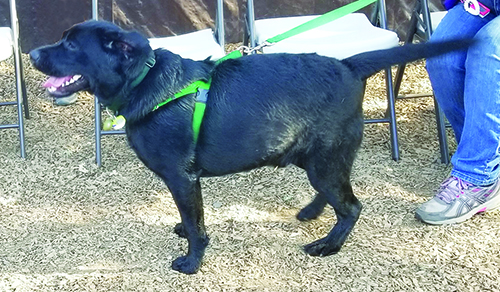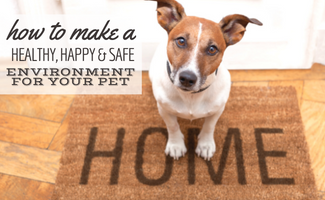How Much Should You Feed Your Dog?
A year or so ago, I was taking pictures at a “teen dog social,” which was attended by some 6-month-old dogs I had last seen a few months prior. All of the dogs were maturing into well-mannered young adults – but I worried about two of them. Most of the young dogs present were in good condition, but two were absolutely obese! How does such a young dog get so fat?
My friends know that overweight dogs are one of my pet peeves. (In fact, I very nearly lost my best friend when, shocked, I blurted, “Oh my gosh, how did Carly get so fat?!” when I hadn’t seen her dog for a long time.)
I’m overweight, myself – but it’s something I control; I am solely responsible for the negative effects that being overweight can have on my health. Our dogs, in contrast, can’t be held responsible for their weight and condition; we alone are at fault when we allow them to get fat and end up with health problems associated with obesity: an increase in cancer, high blood pressure, type II diabetes, kidney disease, osteoarthritis, and more.
Obesity in young dogs is even worse: by making dogs carry extra weight on as-yet immature joints and bones with open growth plates, it predisposes the dog to a much higher risk of painful osteoarthritis later in life. Fat young dogs are also at a higher risk of other orthopedic problems – cranial cruciate ligament (CCL) injuries, in particular.
Given the fact that both of the fat young dogs were Labradors – high-energy goofballs – I felt compelled to mention these risks in particular to their owners. (There she goes again!) This time, I didn’t blurt it out; I was tactful. But even so, both sets of owners were shocked; they knew their pets would mature to be “big” dogs and they thought the bulk was just “puppy fat.”
Here’s the clincher: In their defense, both owners said, “We just feed the suggested amount on the label!”
RECOMMENDED FEEDING GUIDELINES
You don’t have to read to the end of this piece; here’s the most important information to take away from this story: You should never feed your dog according to the product’s feeding guidelines without adjusting the amounts to suit your dog!
Dog food manufacturers are required by law to put feeding instructions on their labels, to give dog owners a starting point – an idea of approximately how much of the product should be fed to provide “complete and balanced nutrition” to dogs of varying weights. The feeding directions must state, at a minimum, “Feed (weight/unit) of product per (weight) of the dog.”
These numbers are derived through a calculation that estimates the caloric content of the food and factors it against the average, medium-size dog’s “resting energy requirements” (RER), which represents the energy requirement of a dog at rest at a controlled temperature. The accepted formula for calculating a dog’s RER is 30 times the dog’s body weight in kilograms plus 70. The calculation for a 40-pound (18.14 kg) dog would look like this: 30 x 18.14 + 70 = 614.2 calories.
That might seem helpful to know, but be advised that many factors can affect a particular dog’s RER. Is the dog neutered or spayed? If so, his or her RER will be less. Is the climate very cold? If so, the dog’s RER will be more. Inactive dogs and very large dogs have lower caloric requirements, per pound of body weight. Highly active dogs and small dogs need more calories, per pound of body weight, than the average dog.
The dog’s age also affects his RER. Did you know that puppies require more calories than adult dogs who weigh the same amount? Puppy foods usually show a more complex table for their feeding instructions, one that shows both the puppy’s weight and age. Note that the recommended feeding amount goes down as the dog gets older.
So, good feeding instructions will add something like, “Feeding rates should be adjusted based upon breed type, activity, or environmental conditions.”
The very best feeding instructions will expand even more on this point. Stella & Chewy’s label says, “The table below shows the number of measuring cups to feed each day based on a pet’s weight. Please note these are guidelines, and individual requirements can vary by +/-50% based on your pet’s activity level, metabolism, age, general health, and other factors.” Plus or minus 50%!!
The Scoop on Feeding Amounts


- A measured cup of one food may not contain, by weight, the same amount of food as another measured cup. If the kibble size is very small, the spaces between the nuggets will be smaller, too, resulting in more food by weight in the same volume of space.
- If you use a coffee cup to scoop and measure your dog’s food, be advised that you are likely feeding him more than “one cup” of food; most coffee cups hold more volume than one measuring cup full.
- Kibble is highly nutrient-dense. Whatever cup or scooper you use, be aware that a rounded, over-full scoop will contain a lot more calories than a level scoop. (This is one of the hazards of asking kids or the most soft-hearted member of the family to feed the dog; they tend to overfill the scoops.)
- Weighing your dog’s portions is more precise than using an approximate volume of food. That said, be advised that the caloric content of foods can vary widely; 8 ounces of this food might contain 280 calories, whereas 8 ounces of that food might contain as much as 500 calories. So when you change foods, check the caloric content, and adjust your dog’s portion accordingly.
GETTING PAST THE STARTING POINT
Now you know: The amounts given are just a starting place. So how should you adjust the feeding suggestions in order to give your dog an appropriate amount?
Research scientists have worked out some formulas so one could conceivably multiply any dog’s RER by factors that have calculated for activity and inactivity, cold climates, neuter status, etc. But you don’t need to be a mathematician to work this out! All you need are your eyes and hands. Look at and feel your dog!


When you look at your standing dog from above, you should be able to see a discernible waist, with an hourglass indentation between his ribs and his hips. If your dog is super fluffy, you have to feel for this indentation. If he feels like a sausage (a straight tube) or a lemon (wider in the middle than at the ends), he’s fat.
While you’ve got your hands on your dog, see if you can feel his ribs. Then, take the “knuckle test”: Make a loose fist with one hand. Run the fingers of your other hand across the back of the hand with the fist, then over the knuckles, then over the back of your fingers near the knuckles. If your dog’s ribs feel like the back of your hand, where you can barely feel the bones, your dog is likely too fat. If your dog’s ribs feel like your knuckles, he’s likely too thin. If his ribs feel similar to the backs of your fingers near your knuckles, where you can feel each rib but they are slightly padded, he’s probably at a good weight.
If you discern that your dog is overweight, reduce the amount of calories that you feed him! And, if you both are able, increase his exercise. That’s the super-short version of an article we’ll bring you in a future issue on strategies for safe weight-reduction. But if your dog is fat, don’t wait to get started: Cut his portion size now!





I’ve been absent for some time, but now I remember why I used to love this web site. Thank you, I?¦ll try and check back more frequently. How frequently you update your website?
I have been browsing on-line greater than 3 hours nowadays, yet I by no means discovered any fascinating article like yours. It is beautiful value sufficient for me. Personally, if all web owners and bloggers made good content as you did, the net will likely be much more helpful than ever before.
Thank you for the auspicious writeup. It in fact was a amusement account it. Look advanced to far added agreeable from you! By the way, how could we communicate?
I consider something really special in this internet site.
Awesome blog! Is your theme custom made or did you download it from somewhere? A theme like yours with a few simple adjustements would really make my blog stand out. Please let me know where you got your design. Many thanks
I appreciate, cause I found just what I was looking for. You have ended my four day long hunt! God Bless you man. Have a great day. Bye
That is very interesting, You’re a very skilled blogger. I’ve joined your feed and look ahead to in quest of more of your excellent post. Additionally, I have shared your site in my social networks!
I am now not positive where you are getting your info, however good topic. I must spend a while learning much more or understanding more. Thank you for excellent information I used to be searching for this information for my mission.
You are my breathing in, I possess few web logs and occasionally run out from to post : (.
But wanna state that this is very beneficial, Thanks for taking your time to write this.
Whats up very cool website!! Man .. Beautiful .. Wonderful .. I’ll bookmark your website and take the feeds also…I’m happy to find numerous helpful info here within the publish, we need work out extra techniques in this regard, thanks for sharing.
he blog was how do i say it… relevant, finally something that helped me. Thanks
I think this site holds some real fantastic info for everyone : D.